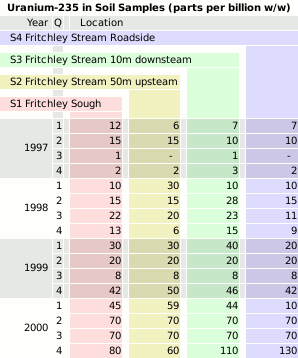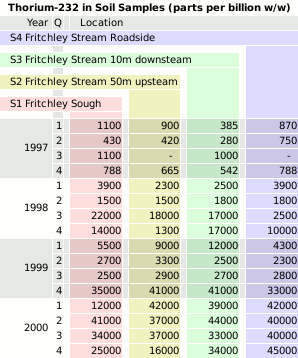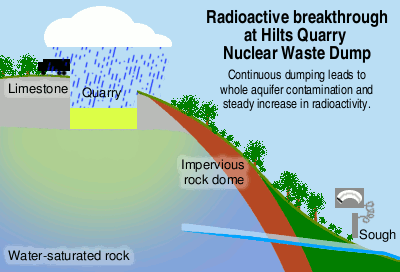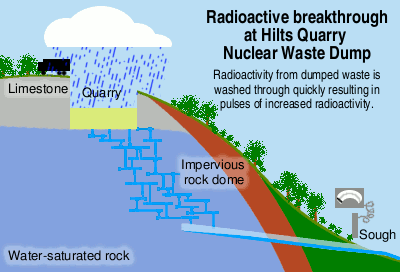|
Let the Devil Wear Black | James F Linden. The true story of the Courtaulds Cancer-Gas Scandal. |
Resources - Hilts Breakthrough
Levels of certain elements show something is going on.
Chapter 24
A nuclear waste dump — or, perhaps we should say ‘nuclear waste storage facility’ — shouldn’t allow any of its content to escape into the local environment. At all.
However, you will have seen from these pages that Hilts quarry leaks like a sieve into the local environment, mainly for the reason that all of the requirements for a secure nuclear waste storage facility are not present at Hilts.
It only makes sense to monitor the main locations through which you think that the quarry’s contents will making an exit and this has been done.
Here, you can see the results for the level of Uranium–235 in soil samples taken where Fritchley sough runs into the stream. On is from the sough itself (S1), two are from the stream, taken 50m upstream of where the sough flows into it (S2) and the other from 10m downstream (S3) and the other from the roadside (S4).
Those are just the soil samples. There were plenty of other samples taken of water from Fritchley and Meerbrook soughs and herbage from ‘Crich Tip positions’ and from Fritchley stream roadside.
They were monitored for Cobalt–60, Radium–226, Thorium–232, Uranium–235 and Uranium–238.
The units they were measured in were for the first two, Bq/Kg (Becquerels per Kilogramme) a Becquerel is a count on a Geiger counter so the background radiation is around 3Bq and the number of counts per second per kilo gives you an idea of the concentration. They can tell which element is giving off a particular count because the amount of energy is different for each element.
The other three were measured in ng/g (nanogrammes per gramme) or to put it into a way that is easier to visualise, if you imagine it as mg/tonne or cubic millimetres per cubic metre. One ng/g is one cubic millimetre in one cubic metre.
In the tables, you can see that the levels of all of the samples tend to go with each other — the upstream samples should give a background level that is fairly stable as all of these elements apart from the Cobalt–60 are naturally occurring in that area and have achieved a stable level over the years since the rock was formed, hundreds of millions of years ago. That is reflected in the water samples but in the soil samples, these go up and down with the other levels in the soil samples suggesting that the whole area is contaminated, probably from radioactive dust being blown around when it dries out.
One interesting thing that you can see both in the Uranium–235 and the Thorium–232 tables is that the levels increase to a maximum in 1998Q3 and then go down again.
Having reached a minimum around the middle of 1999 — the Uranium–235 reaches quite a low at 1999Q3 — the levels then shoot up again by an order of magnitude to the levels at 2000Q4.
So, what does this suggest — other than a complete failure to contain the radioactivity within the quarry?
There are two main mechanisms for the leaching out of the radioactive elements in the quarry.
The first is that the radioactive sand and the waste that is ‘free–tipped’ into it — that is to say, emptied out of the drums into a hole in the sand — have their radioactive isotopes leached out in the rainwater which then contaminates the aquifer. Over the years, the concentration builds up and it then starts to appear in the soughs.
This would mean that the whole aquifer underneath Crich was contaminated with radioactive water and to clean it up, it would take many years of trying to flush it out.
One artefact of this model is that the level gradually builds up over the years and what you see at the monitoring points, as the levels increase, is just the beginning of more to come — a lot more.
An alternative is that the contaminated water runs through fissures in the bottom of the quarry and finds itself fairly quickly in the soughs.
There would, due to the porous nature of limestone, be some radioactivity held back that soaked into the limestone as the water went on its way to the sough, through the cracks and that would give the levels at the soughs smoothed levels of radioactivity as it is monitored.
In reality, it is probably a mixture of the two models.
“Well, they are working for Gazelles. Now, as long as they work for Gazelles, they're not working for anybody else and that can only be for the benefit of everybody else.”
Copyright © 1994-2023 James F Linden. All Rights Reserved.





